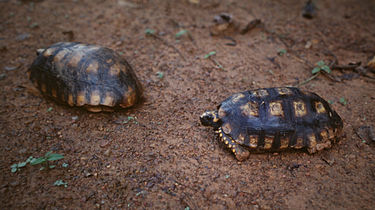| Place of Origin and Range |
The Yellow-Footed Tortoise , also known as the Brazilian giant tortoise. It is found in the Amazon Basin of South America. |
| Description |
The carapace is yellowish brown to dark brown or even black at the edges of the scutes. The areola in each scute are pale yellow, orange or light brown and blend into the darker carapace.The plastron (shell bottom) is thick around the edges, and the gulars (front pair of palstron scutes) do not project past the carapace. The plastron is yellow-brown turning nearly black near the seams. The head is relatively small and longer than wide. The upper jaw has three tooth-like points. There are large black eyes with a tympanum behind each eye. |
| Morph Patterns Available |
Yes |
| Adult Size |
Can grow up to 94 cm (37 in) |
| Accommodation |
Their natural habitat ranges from savannah to forest-edges around the Amazon Basin. As long as a heat source and lots of water are present your turtle will be happy. Some feel they prefer grasslands and dry forest areas, and that rain-forest habitat is most likely marginal. Others suggest humid forest is the preferred habitat. Regardless, they are found in drier forest areas, grasslands, and the savanna, or rainforest belts adjoining more open habitats. |
| Lifespan |
Can live 20+ years |
| Feeding / Diet |
This South American tortoise eats many kinds of foliage. They are too slow to capture any fast animals. In the wild, their diets consist of grasses, fallen fruit, carrion, plants, bones, mushrooms, excrement, and slow-moving invertebrates such as snails, worms, and others they are able to capture. In captivity, they are fed oranges, apples, melons, endive, collard greens, dandelions, plantain, ribwort, clover, shredded carrots, insects, worms, cuttlebone, tortoise vitamins, edible flowers, and alfalfa pellets. |
| Breeding |
Breeding is synchronized with the onset of the rainy season (from July to September), where a general increase in activity is noted. Males identify each other by eliciting a characteristic head movement, a series of jerks away from and back to mid-position. Another male will make the same head movements. No head movement in response is the first indication that the other tortoise is a female. Scientific experimentation and observation has also indicated head colouration has to be correct. He will then sniff the cloacal region of the other tortoise. Copulation usually follows, though sometimes there is a period of biting at the legs. During courtship and copulation, the male makes clucking sounds very much like those of a chicken, with a set pattern in pitches of the clucking sounds. Rival males will battle, attempting to overturn each other, but neither the males nor females will defend a territory. They are considered nomadic in their movements. Interestingly, in almost every tortoise species where male combat occurs, the males are always larger than the females. This is in comparison to aquatic species, where the males are usually smaller than the females and do not engage in male-to-male combat. Species with male combat are thought to have evolved larger males because they have a better chance of winning a bout and mating with a female, thus passing on their larger size to their offspring. |
| Other Considerations |
Watch for theses health concerns carefully with your tortoise. Vitamin A Deficiency: Vitamin A is an important nutrient for your tortoise’s health. It is found in his diet in the form of leafy green, orange or yellow vegetables, liver, and fish. If your tortoise is not getting enough Vitamin A, he can suffer serious health problems. Always check to make sure that your tortoise does not have swollen eyelids, as this is the main sign of a Vitamin A deficiency. Also, check for weight loss, nasal discharge and infected skin. Any of these symptoms could point to a deficiency. If you think your tortoise may not be getting enough Vitamin A, you should take him to the veterinarian to get a firm diagnosis. Shell Problems: Your tortoise's shell is very important to his overall health. There are many potential problems that could occur, so you should be on the lookout at all times. Respiratory Disease: Respiratory infections have symptoms similar to vitamin A deficiency, including swollen eyelids and runny nose, so you should take your tortoise to the veterinarian to get a proper diagnosis if you suspect either. More serious infections will be characterized by breathing through the mouth, mucus in the mouth, and wheezing. Always make sure your tortoise’s environment has the proper amount of humidity, as this will help prevent respiratory problems. |




